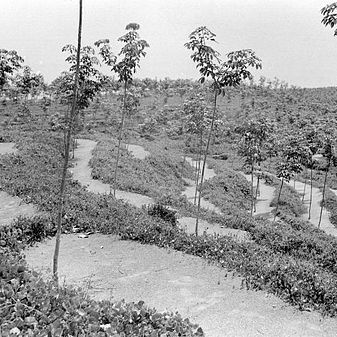Herbaceous or woody climbers or trailers. Leaves pinnately 3-foliolate; stipels present. Flowers blue or violet, small, in fascicles arranged in short to long axillary nodose pseudo-racemes, or in axillary subsessile fascicles; bracts and bracteoles small, deciduous. Calyx campanulate or shortly tubular, 5-lobed, the upper pair free or ± connate to form a 2-toothed lip. Standard obovate, auriculate at the base, the auricles inflexed; wings narrow, adhering to the obtuse keel. Vexillary stamen free; anthers mostly 8–9, all similar. Ovary sessile, many-ovuled; style filiform or subulate, usually ± incurved, glabrous or pubescent; stigma terminal, capitate. Pods linear or linear-oblong, ± compressed, 2-valved, dehiscent, mostly septate between the seeds, the outer surface transversely furrowed, giving the pod the appearance that it might break into segments. Seeds compressed-globose or oblong.
Herbs, twining or procumbent. Stems somewhat woody at base. Leaves pinnately 3-foliolate, stipulate; leaflets stipellate. Racemes axillary. Flowers small or moderately large, clustered at nodes of inflorescence rachis. Pedicels very short; bracts and bracteoles small, deciduous. Calyx campanulate or tubular; teeth 5, upper 2 ± connate. Corolla blue or purple; standard obovate, with 2 incurved auricles at base; wings narrow, auriculate, adnate to keel; keel shorter than wings, blunt and slightly curved. Stamen opposite to standard, free, others connate. Ovary sessile, many ovuled; style filiform; stigma capitate, small and terminal. Legumes linear or oblong, dehiscent, slightly compressed or biconvex, transversely corrugated between seeds. Seeds rounded, slightly compressed, without strophiole.
Pods linear or linear-oblong, ± compressed, 2-valved, dehiscent, mostly septate between the seeds, the outer surface transversely furrowed, giving the pod the appearance that it might break into segments.
Flowers blue or violet, small, in fascicles arranged in short to long axillary nodose pseudoracemes, or in axillary subsessile fascicles; bracts and bracteoles small, deciduous.
Ovary sessile, many-ovuled; style filiform or subulate, usually ± incurved, glabrous or pubescent; stigma terminal, capitate.
Standard obovate, auriculate at the base, the auricles inflexed; wings narrow, adhering to the obtuse keel.
Calyx campanulate or shortly tubular, 5-lobed, the upper pair free or ± connate to form a 2-toothed lip.
Vexillary stamen free; anthers mostly 8–9, all similar.
Leaves pinnately 3-foliolate; stipels present.
Herbaceous or woody climbers or trailers.
Seeds compressed-globose or oblong.

